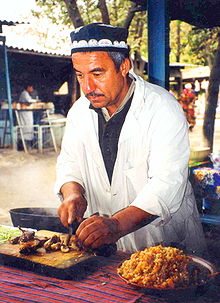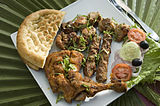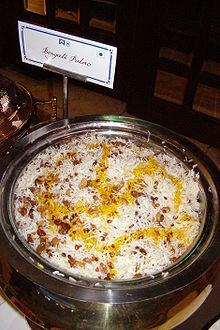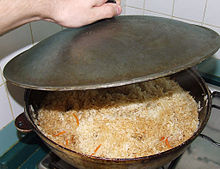- Pilaf
-
Bengali Pulao, a popular dish in Indian cuisine.

Pilaf (for an extended list of local names, see Other names) is a dish in which rice is cooked in a seasoned broth (zirvak).[1] In some cases, the rice may also attain its brown color by being stirred with bits of burned onion, as well as a large mix of spices. The English term pilaf is borrowed directly from Turkish, pilav, which in turn comes from (Classical) Persian pilāw (پلو), and ultimately derives from Sanskrit pulāka- (पुलाक).[2] Depending on the local cuisine, it may also contain a variety of meat and vegetables.
Pilaf and similar dishes are common to Middle Eastern, Central and South Asian, East African, Latin American, and Caribbean cuisines.
Contents
Cuisine
Persian culinary terms referring to rice preparations are numerous and have found their way into the neighbouring languages: Polow (rice cooked in broth while the grains remain separate, straining the half cooked rice before adding the broth and then "brewing"), Chelow (white rice with separate grains), Kateh (sticky rice), Biryani, Tajine (slow cooked rice, vegetables and meat cooked in a specially designed dish also called a tajine). There are also varieties of different rice dishes with vegetables and herbs which are very popular among Persians.
There are four primary methods of cooking rice in Iran:
- Chelow: rice that is carefully prepared through soaking and parboiling, at which point the water is drained and the rice is steamed. This method results in an exceptionally fluffy rice with the grains separated and not sticky; it also results in a golden rice crust at the bottom of the pot called tah-digh (literally "bottom of the pot").
- Polow: rice that is cooked exactly the same as chelow, with the exception that after draining the rice, other ingredients are layered with the rice, and they are then steamed together.
 A Tajik man makes plov, the national dish of Tajikistan.
A Tajik man makes plov, the national dish of Tajikistan.
- Kateh: rice that is boiled until the water is absorbed. This is the traditional dish of Northern Iran.
- Damy: cooked almost the same as kateh, except that the heat is reduced just before boiling and a towel is placed between the lid and the pot to prevent steam from escaping. Damy literally means "simmered".
In Italian cuisine "pilaf" is a rice pre-cooking style that allows chefs in busy restaurants to cut down time in risotto preparation. Usually a large tray of Carnaroli or Arborio rice will be baked for seven minutes with a large onion and a carrot, in water. After that it will be placed on a marble slab to cool down. Once cooled it will be kept in the fridge and used ad hoc to prepare risotti in a shorter time: 7 to 10 minutes depending on the "al dente" texture that the chef wants to achieve, rather than the usual 16 to 20 minutes.
In Greek cuisine, piláfi is the fluffy and soft, but neither soupy nor sticky, rice that has been boiled in a meat stock or bouillon broth. In Northern Greece it is considered poor form to prepare piláfi on a stovetop; the pot is properly placed in the oven. Gamopílafo ("wedding pilaf") is the prized pilaf served traditionally in weddings and major celebrations in Crete: rice is boiled in lamb or beef broth, then finished with lemon juice and melted staka butter.
In Tajik and Afghan cuisine, qabili palau is made by cooking basmati in a broth-like sauce. This dish may be made with lamb, chicken, or beef. Qabili Palau is baked in the oven and topped with fried sliced carrots and raisins. Chopped nuts like pistachios or almonds may be added as well. The meat is covered by the rice or buried in the middle of the dish.
In South Asia, pulao (sometimes spelt 'pulav') is a dish consisting of rice and commonly including peas, potatoes, mutton, beef, or chicken. It is usually served on special occasions and weddings and is very high in food energy and fat. Meat pulao is a North Indian tradition, especially among the Muslim population. Biryani is a dish similar to pilaf introduced to Indian Cuisine during the Mughal period. It is made from basmati or similar aromatic rice.
In Persian cuisine Rahkshi (also known as yahni), a soup or stock, is often served over pilaf (pulao).
Uzbek plov on the other hand differs from other preparations in that rice is not steamed, but instead simmered in a rich stew of meat and vegetables called zirvak until all liquid is absorbed into the rice, although some limited degree of steaming is commonly achieved by covering the pot. Plov is commonly prepared with lamb or mutton, browned in lamb fat or vegetable oil, and then stewed for several hours with fried onions and carrots, although beef could be substituted in a pinch. Chicken plov is rare and usage of pork is discouraged. It is usually spiced with cumin, coriander, barberries and garlic, with the whole bulbs buried in rice during cooking, although sweet variations, with dried apricots and raisins aren't unheard of.
History
One of the earliest literary references to Palau can be found in the histories of Alexander the Great when describing Bactrian hospitality. (Bactria was an eastern province in greater Iran, probably the birthplace of Alexander's wife Roxana and geographically located in modern Afghanistan). It was known to have been served to Alexander the Great upon his capture of the Sogdian capital of Marakanda (modern Samarkand). Alexander's army brought it back to Macedonia and spread it throughout Eastern Europe.
It is believed that proper preparation of pilaf was first documented by the tenth century Persian scholar Abu Ali Ibn Sina (Avicenna), who in his books on medical sciences dedicated a whole section to preparing various meals, including several types of pilaf, and described advantages and disadvantages of every item used for preparing it. Accordingly, some Tajiks consider Ibn Sina to be the "father" of modern pilaf.
Pilau became standard fare in the Middle East over the years with variations and innovation by the Persians, Arabs, Turks and Armenians. It was introduced to Israel by Bukharian and Persian Jews.
During the years of the Soviet Union, the dish spread throughout the other Soviet republics, becoming a favorite in such diverse places as Russia, Ukraine, and Georgia.
- Rice pilaf examples
-
Osh palov, the national dish of Uzbekistan and Tajikistan, is a staple dish in Bukharian Jewish cuisine.
-
Qabili pilau is the national dish of Afghanistan.
-
Paulao prepared using the Punjabi style, part of Pakistani cuisine.
Other names
- Albanian: pilaf
- Armenian: փլավ plav
- Assamese: পোলাও polao
- Azerbaijani: plov, aş
- Bengali: পোলাও polao, পোলাউ polau
- Bosnian: pilav
- Bulgarian: пилаф
- Caribbean: pelau
- Catalan: (Arròs) pilaf
- Crimean Tatar: pilâv
- Danish: pilaf
- Dutch: pilaf
- English: pilau, pillau[3]
- Estonian: pilaff
- Finnish: pilahvi
- Gagauzian: pirinc
- Greek: πιλάφι piláfi
- Gujarati: પુલૌ pulau, પુલાવ pulāv
- Hebrew: אושפלוב oshpalov, פלוב plov, פילאף pilaf
- Hindi: पुलाव pulāv
- Hungarian: piláf
- Italian: pilaf
- Kannada: ಪಲಾವ್ palāv
- Kazakh: палау; [paláw]
- Korean: 필라프 pillapeu
- Kyrgyz: палоо, аш, плов; [pɑloː, aʃ, plof]
(origins: Persian, Turkic, Russian) - Latvian: plovs
- Lithuanian: plovas
- Macedonian: пилав pilav
- Mandarin: 抓飯 zhua fan
- Marathi: पुलाव pulāv
- Moldovan: pilaf
- Nepali: पुलाउ pulāu
- Norwegian: pilaff
- Oriya: palaauu
- Pashto: پلو pilau/polow
- Persian: پلو polow/polo
- Portuguese: arroz pilau
- Polish: pilaw [ˈpilaf]
- Romanian: pilaf
- Russian: плов; [ˈpɫɔf]
- Serbian: пилав pilav
- Sindhi: pulah, plaoh
- Swahili: pilau
- Swedish: pilaff
- Tagalog Language: pilaw
- Tajik: палав palav, ош osh
- Tatar: pɪlaw; [pəlaw]
- Trinidad and Tobago: pelau
- Tamil: pulau
- Telugu: palav
- Turkish: pilav
- Turkmen: palaw
- Ukrainian: плов (plov)
- Urdu: پلاؤ pulao
- Uyghur: پولۇ polo
- Uzbek: palov, osh; [palɒw, ɒʃ]
See also
Other mixed rice dishes
- Arroz con Pollo, Arroz con gandules, Platillo Moros y Cristianos, Gallo Pinto, Pabellón criollo, Rice and beans (Latin America)
- Fried Rice (East Asia)
- Jambalaya (Louisiana)
- Jollof rice (West Africa)
- Hoppin' John (Southern United States)
- Kabsa (Saudi Arabia)
- Kedgeree (United Kingdom)
- Nasi Goreng (Indonesia)
- Paella (Spain)
- Rice and peas (Caribbean)
- Risotto (Italy)
- Spanish rice (United States of America)
- Takikomi gohan (Japan)
References
- ^ "Rice Pilaf". Ricecookerfetish.com (website). Accessed May 2010.
- ^ http://dsal.uchicago.edu/cgi-bin/philologic/getobject.pl?c.2:1:1544.soas
- ^ Thackery, Vanity Fair, Ch. 3.
External links
- Recipes & descriptions of variety of Persian rice dishes
- Uzbek Palov Osh Recipe
- All About Pilaf, History and Recipes
Cuisine of Cyprus Mezedhes Cheeses Dishes Afelia · Ambelopoulia · Avgolemono · Couscous · Fried eggplant · Fasolada · Gyros · Keftedhes (Kuftah) · Kléftiko · Koupepia (Dolmades) · Macaronia tou Fournou · Moussaka · Moukentra (Mujaddara) · Pastourma · Pilafi · Sheftalia · Souvla · Souvlaki · Stuffed Marrow · Tavvas (Tajine) · Tsamarella · YahniDesserts Baklava · Flaounes · Gliko · Halvas · Kothropita · Koupes · Lâpa · Loukoumades · Loukoumi (Turkish/Cyprus Delight) · Mahlab · Soutzoukos · Tiropita · Tsoureki · TulumbaDrinks Ayrani · Commandaria · Brandy Sour · Cypriot coffee · Cyprus brandy · Cyprus wine · Frappé coffee · Triantafylon (Rose syrup) · ZivaniaPakistani dishes by cuisine and region Balochi 
Kashmiri Muhajir Aloo tikki · Dahi chutney · Gil e firdaus · Hyderabadi biryani · Haleem · Masala chai · Nargisi Kofta · Nihari · Paan · SheermalPashtun Afghan bread · Bolani · Chapli kabab · Gosh Feel · Kabuli pulao · Kadchgall · Kadu bouranee · Kahwah · Mantu · Peshwari NaanPunjabi LahoriChargha · Golgappa · Halwa poori · Lahori fried fish · Gosht karahi · Murgh cholay · Paya · Kata-katElsewhereAloo gobi · Aloo paratha · Baingan ka bartha · Bhala · Bhatoora · Chana masala · Chapati · Chicken tikka · Chole bhature · Gajar ka Halwa · Lassi · Makki di roti · Panjiri · Papadum · Paratha · Punjabi pulao · Puri · Sarson da saag · Sohan halwa · Sugarcane juice · Tandoor bread · Tandoori chicken · TikkaSindhi Miscellaneous Pakistani diaspora Categories:- Iranian loanwords
- Persian loanwords
- Turkish loanwords
- Albanian cuisine
- Tajik cuisine
- Armenian cuisine
- Azerbaijani cuisine
- Bulgarian cuisine
- Bosnia and Herzegovina cuisine
- Central Asian cuisine
- Greek cuisine
- Greek cuisine pilavs
- Cypriot cuisine
- Uttar Pradeshi cuisine
- Levantine cuisine
- Kazakhstani cuisine
- Montenegrin cuisine
- Pakistani cuisine
- Bengali cuisine
- National dishes
- Rice dishes
- Romanian dishes
- Serbian cuisine
- Uzbekistani cuisine
- Uzbekistani culture
- Turkish cuisine
- Indian rice dishes
- Turkish cuisine pilavs
Wikimedia Foundation. 2010.






